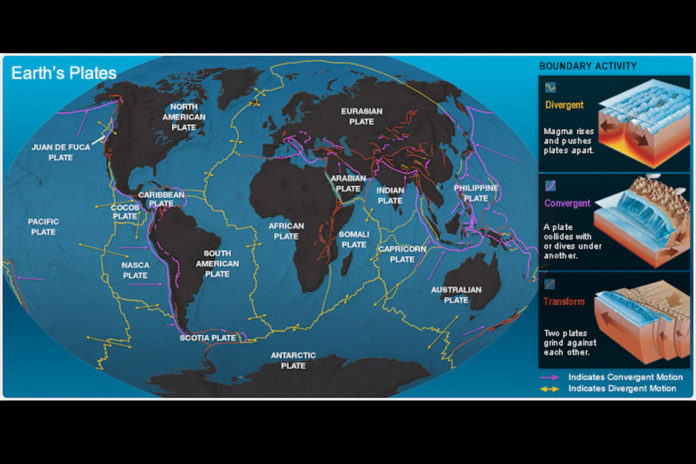Tectonic plates are part of the earth’s lithosphere. The lithosphere is the outer shell of the planet. However, instead of a solid outer shell, the lithosphere is broken into smaller pieces. These pieces resemble a broken eggshell and are known as tectonic plates.
Continental and Oceanic Plates
The solid tectonic plates float on a fluid aesthenosphere. The floating plates move around slowly. Where one plate meets another, a plate boundary exists.
There are two types of tectonic plates.
Continental plates: are thick but less dense plates.
Oceanic plates: are less thick but made of a heavier and more dense material.
Plate Boundaries and Landforms
A plate boundary is where two plates meet. Several things can happen at a plate boundary. There are three basic types of plate boundaries.
Diverging Plate Boundaries
Diverging boundaries occur when two plates move away from one other.
Oceanic Plates: When diverging plates are oceanic plates molten material rises up to the ocean floor. This creates a mid-ocean ridge of volcanoes. The Mid-Atlantic Ridge is an example of this.
Continental Plates: If the diverging plates are continental plates, then a rift valley is created. As the rift continues to widen, it may be filled in with sea water. The African Rift Valley and the Red Sea are examples of plate divergence.
Converging Plate Boundaries
Converging boundaries occur when two tectonic plates move towards one another.
Denser Plate: In these zones, the more dense tectonic plate is driven downward into the earth. The plate gradually melts and is destroyed. If the boundary is below the sea, an ocean trench is created. The Marianas Trench is an example of this.
Less Dense Plate: On the other hand, less dense plates may be deformed and folded. Mountain systems and island arcs are created in this process. The Himalayas and the Philippine Islands are examples. Stratovolcanoes are commonly formed in these areas.
Transform Boundaries
Transform boundaries occur when two plates move horizontally to one another. New crust is not created or destroyed. However, these tend to be areas that experience strong earthquakes. The San Andreas fault in California is an example of this kind of boundary.
Reflections
Vocabulary
- aesthenosphere
- ocean trench
- tectonic plate
Notes
- Tectonic plates are large pieces of the solid earth’s crust floating on a fluid asthenosphere.
- Plate boundaries are where two tectonic plates meet.
- Continental and oceanic landforms are created at plate boundaries.
Bibliography

